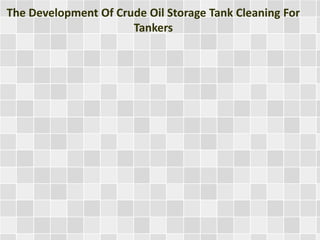
The Development Of Crude Oil Storage Tank Cleaning For Tankers
- 1. The Development Of Crude Oil Storage Tank Cleaning For Tankers
- 2. Crude oil storage tank cleaning, or commonly called Crude Oil Washing (COW), is mainly the process of cleaning the storage using the oil itself. Prior to strict environmental regulations, tankers were cleaned using jets that sprayed seawater inside the containers. Also, before ballast tanks were introduced in ship design, water had to be stored in order for the propeller to be properly immersed at sea.
- 3. After some time, multiple regulations has been introduced to lessen the waste produced when cleaning the tanker ships after every trip. The owners of these vessels have also found ways to use these regulations in order to lessen the oil waste to decrease costs in running them. In here, we will be tackling the many advancements for the past few decades up until the current regulations of the industry.
- 4. Thousands of tanker ships carry oil from rig platforms to refineries for processing every day. Thus, it is important to ensure the profitability of each delivery and to lower costs as much as possible. One easy way was to clean the tanks that were storing fuels regularly. If left unattended, the fuels will form a sticky layer on the walls that will not be transferred to the refinery and will be weight that the tanker would need to carry on its way back to the platform.
- 5. Initially, the cleaning method used was to pump in heated seawater and jet sprayed to remove the layer of oils from the surface, which were then pumped overboard. This method resulted in high amounts of fuel being discharged into the sea. Pollutants were highly concentrated on piers and docks where the ships were being cleaned.
- 6. In 1954, the Oil Pollution Convention (OILPOL) was adopted as a measure to lessen pollution through the prohibition of the release of waste within 50 miles from the nearest land. On some instances, this limit was extended to 100 miles on environmentally protected sites, where the spillage may have very grave impacts.
- 7. Due to the pollution that was still being produced by the OILPOL adaption, a new process was introduced where the tanks were still cleaned using pressurized heated water, but instead of disposing the waste, it is first placed into a special slop tank. While the ship is on its return voyage, the oil, which is lighter than water, would eventually float on top. The water, which settled at the bottom, will be returned to the sea. This process is called the Load on Top.
- 8. The Load on Top was very successful that an approximate of 8 million tons of fuel per year was saved from being dumped into the sea. It also made significant savings for the companies that owned the ships as the oil that remained after removing the sea water was simply topped with fresh new crude oil.
- 9. Another improvement for the crude oil storage tank cleaning process was once again introduced and called the Crude Oil Washing, which used pressurized fuel and sprayed onto the walls to remove the layered sediments that got stuck. This latest process eliminated the use of water, thus removing the need to separate the petroleum from a cleansing agent that would usually produce waste.